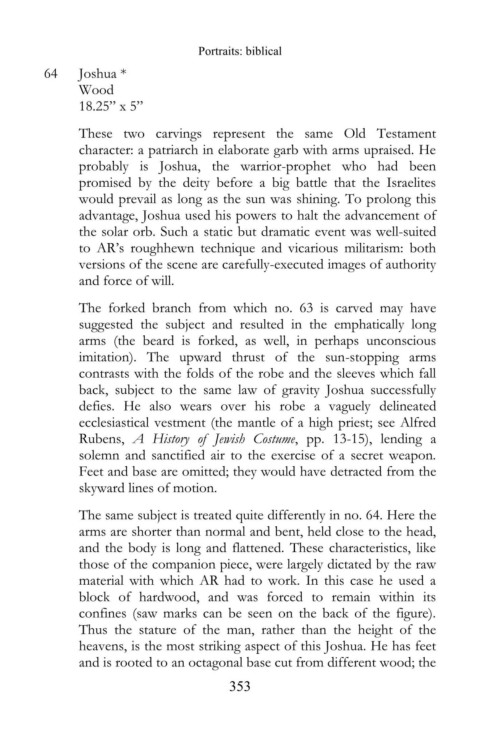Page 357 - The Legacy of Abraham Rothstein - text
P. 357
Portraits: biblical
64 Joshua *
Wood
18.25” x 5”
These two carvings represent the same Old Testament
character: a patriarch in elaborate garb with arms upraised. He
probably is Joshua, the warrior-prophet who had been
promised by the deity before a big battle that the Israelites
would prevail as long as the sun was shining. To prolong this
advantage, Joshua used his powers to halt the advancement of
the solar orb. Such a static but dramatic event was well-suited
to AR’s roughhewn technique and vicarious militarism: both
versions of the scene are carefully-executed images of authority
and force of will.
The forked branch from which no. 63 is carved may have
suggested the subject and resulted in the emphatically long
arms (the beard is forked, as well, in perhaps unconscious
imitation). The upward thrust of the sun-stopping arms
contrasts with the folds of the robe and the sleeves which fall
back, subject to the same law of gravity Joshua successfully
defies. He also wears over his robe a vaguely delineated
ecclesiastical vestment (the mantle of a high priest; see Alfred
Rubens, A History of Jewish Costume, pp. 13-15), lending a
solemn and sanctified air to the exercise of a secret weapon.
Feet and base are omitted; they would have detracted from the
skyward lines of motion.
The same subject is treated quite differently in no. 64. Here the
arms are shorter than normal and bent, held close to the head,
and the body is long and flattened. These characteristics, like
those of the companion piece, were largely dictated by the raw
material with which AR had to work. In this case he used a
block of hardwood, and was forced to remain within its
confines (saw marks can be seen on the back of the figure).
Thus the stature of the man, rather than the height of the
heavens, is the most striking aspect of this Joshua. He has feet
and is rooted to an octagonal base cut from different wood; the
353

